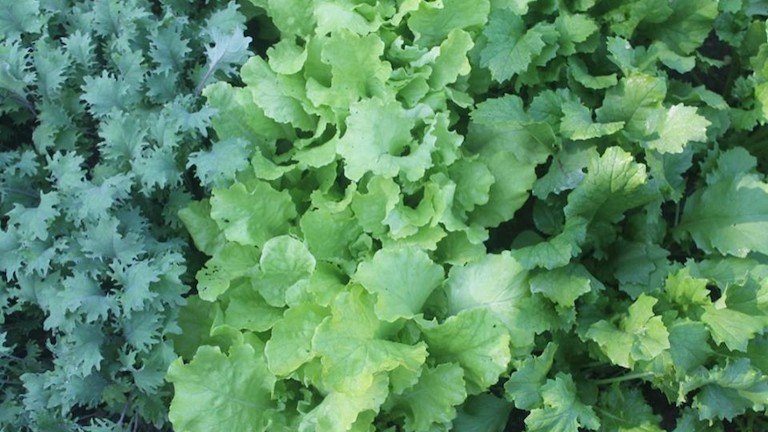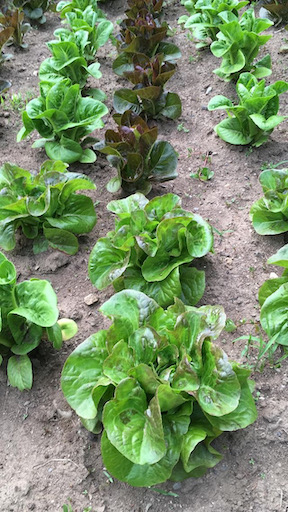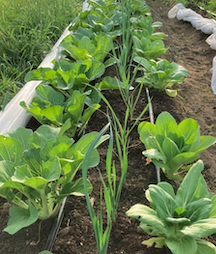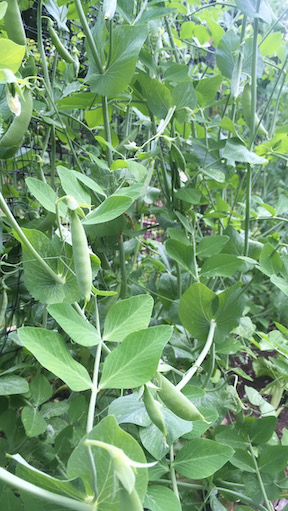By Will Bonsall
Succession planting may refer to two or more garden practices. For quick-maturing crops like lettuce or radishes or spinach, one makes frequent small plantings — perhaps one every week or two — to ensure a steady harvest over a longer period. Planting your whole radish crop at once guarantees that you’ll have far more radishes than you can use until they have all gone by and you have none. Other crops that work this way include lettuce, endive, escarole, radicchio, scallions, spinach and kale, and to a lesser extent peas and green beans. Now these are all sown in different spaces; that is, if you sow lettuce where you’ve just removed a lettuce crop, obviously it will be weeks before you have a new crop, whereas if your new sowing is somewhere else (perhaps the next row over), your second crop can be mere days behind the first crop, depending on when you sowed it, with no gaps in the ongoing harvest.

Successions of cold-hardy leafy greens — such as the Red Russian kale, Tokyo Bekana Chinese cabbage and Mizspoona seen here — can be sown every two to three weeks from early spring through late summer. Holli Cederholm photo
Now what about crop rotation (which is a whole other matter, right)? Isn’t it bad to follow lettuce with lettuce with lettuce? Then one might ask, what’s the difference between several succession sowings of the same crop and a single sowing of some other crop which requires the whole season, like tomatoes, anyway? Arguably none, though there’s no harm in having rotations within the season for the same reasons one rotates from year to year: to reduce pest pressure, avoid soil fatigue (by queueing crops with different fertility needs) and averting buildup of plant or soil diseases. Again, if one’s succession plantings are in different spaces, then rotation is simple enough: one might for example follow early spinach with radishes followed by midseason lettuce followed by fall scallions, shuffling the sequence in other areas so one has constant production of each crop.

Planting different varieties of the same crop, i.e., head lettuce, that have different maturation windows allows for continual harvest. Holli Cederholm photo
Another huge advantage to succession planting (beyond uninterrupted harvests) is to squeeze more production out of a limited space and time. Maine has a relatively short growing season and many gardeners assume we’re lucky to get even a single harvest of long-season crops like peppers — how can we hope to get a second or third crop from those growing areas like gardeners further south? The answer is: by clever timing and use of cold-hardy crops. For example, melons cannot be planted out before Memorial Day (unless you have elaborate frost-protection), so that leaves several weeks between snow-go and melon-planting, weeks when frost is likely but cold-hardy crops can make use of that space. Let’s say one seeded early lettuce in that cold ground — lettuce is fine with that, only it grows slowly at first. That crop may be completely out of there by melon-planting time, especially if it’s leaf lettuce. But what if it’s head lettuce and needs a bit more time to reach market size? Several things can be done to compress the crops’ schedules into a short Maine season.

Instead of direct seeding the lettuce, we might set out pre-started seedings (of the very hardiest varieties). We might even give slight protection with row cover (the seedlings will still get chilled but not as severely). Then if we start the melons in peat pots in early May, we might delay setting them out until mid-June without retarding the crop (especially since the delay may be more than made up for by warmer soil). Or we can plant the melons after threat of frost and let the two crops grow together for a while until the melons start to run and demand all the space for themselves. I often sow my “quick crops,” like lettuce, in rows 2 feet from the melon row so the vines have time and space to spread. Such overlapping can effectively add a few weeks to Maine’s short season.
In addition to lengthening the season with early succession crops, we can do the same at the other end of the season. For example when cold tender crops like tomatoes or peppers get wiped out by the first fall frost, we often assume the season is over for that space. However if we have lettuce, kale, scallions or other seedlings of cold-hardy crops available, we can put that newly released ground into fall production.
Of course all this succession planting requires a lot of already-started seedlings. I meet that need by having several “nursery beds,” measuring perhaps a square yard. I seed it very thickly to the succession crop, much more densely than I would for a growing crop. When any space opens up I just take what I need from those tiny beds. And by the way, I have a trick to avoid transplant shock: before replanting the seedlings in their new home I pinch off a lower leaf of each to balance the top with the disturbed roots. My transplants experience little or no wilting.
Succession planting can also require more seed than usual, which can get rather pricey unless you (have I said this before?) learn to grow and save your own seed!
Here’s another trick I use: to ramp up production of early scallions, as direct-seeded scallions grow quickly but sometimes not quickly enough for me, I sow Egyptian (top-set) onion bulbils late the previous fall. They’ll get off to a much earlier start. To that end I keep a small nursery bed in the perennial garden to ensure a steady supply of bulbils.

Sow peas every two to three weeks starting in the spring for harvests into the summer; a mid-July planting extends harvests into the cooler weather at the end of the season. Holli Cederholm photo
Shell, snap and snow peas need to be succession-planted to provide steady yields throughout the summer (although one can get some of the same effect by using varieties with different maturity dates). Since most pea varieties have a wider window of maturity (compared to, say, radishes), planting every two or three weeks should suffice. A problem there is that with the arrival of hot, dry mid-summer weather, early-sown peas will languish while summer-sown peas may fail altogether (though there are some varieties like Wando which tolerate heat well). In my experience heat-tolerant pea varieties tend to have poorer flavor, but then again, to my taste there’s no such thing as a bad pea. On the other hand, peas, especially snow peas, when planted in mid to late July (in succession to early peas or other early crops) will be coming into their own just when heat stress is lower and shortening days allow the crop to stand better.
Bush green and wax beans likewise need to be succession-planted to ensure a steady supply. Unlike peas, beans are cold-tender at either end of the season. I generally avoid the need to succession-plant beans at all by planting a variety of pole beans called Jimenez that start bearing just a bit later but keep right on cranking out luscious beans throughout the whole season.
Most folks plant cucumbers and zucchini as a one-time planting, but I often plant a second crop in July. That’s because those crops tend to slacken production as the plants senesce (read “grow old”), whereas the second planting will be at their peak toward the end of the season.
Keep in mind that succession crops planted in late summer will require lots more water just to germinate, let alone thrive.
Do you need to add fertility for succession crops? Not necessarily, if the tilth was adequate in the first place. What’s the difference between one long-season, late-maturing crop and several short ones?
There are so many variations on these ideas that you can invent on your own. In the book “Farmers of Forty Centuries,” F. H. King writes about sustainable intensive farming in China in the early 20th century and describes some crops being planted or transplanted into already-growing crops such as grain, ready to burst to life just as the older crop is being removed. Is this succession planting or companion planting or both? Does it matter? I note he is observing these practices in a climate with a year-round growing season, but cheap labor, scarce land and high food prices. We may share some but not all of these factors and must adjust our own practices accordingly. Whether your need is for an unbroken supply of quick-growing produce or to maximize time gaps between early and late crops, succession planting can allow you to use both space and time more efficiently.
About the author: Will Bonsall lives in Industry, Maine, where he directs Scatterseed Project, a seed-saving enterprise. He is the author of “Will Bonsall’s Essential Guide to Radical Self-Reliant Gardening” (Chelsea Green, 2015). And indeed, he is also a distant cousin of another exemplary Maine horticulturist: Tom Vigue. You can contact Will at [email protected].
